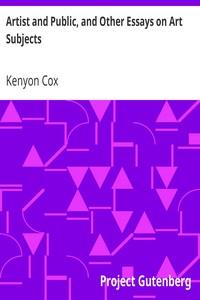|
|
Read this ebook for free! No credit card needed, absolutely nothing to pay.Words: 36516 in 6 pages
This is an ebook sharing website. You can read the uploaded ebooks for free here. No credit cards needed, nothing to pay. If you want to own a digital copy of the ebook, or want to read offline with your favorite ebook-reader, then you can choose to buy and download the ebook. or may not be great, but he is certainly incomprehensible and probably a little mad. Until he succeeds the public looks upon the artist as a more or less harmless lunatic. When he succeeds it is willing to exalt him into a kind of god and to worship his eccentricities as a part of his divinity. So we arrive at a belief in the insanity of genius. What would Raphael have thought of such a notion, or that consummate man of the world, Titian? What would the serene and mighty Veronese have thought of it, or the cool, clear-seeing Velazquez? How his Excellency the Ambassador of his Most Catholic Majesty, glorious Peter Paul Rubens, would have laughed! The salon picture, in its merits and its faults, is peculiarly French, but the modern exhibition has sins to answer for in other countries than France. In England it has been responsible for a great deal of sentimentality and anecdotage which has served to attract the attention of a public that could not be roused to interest in mere painting. Everywhere, even in this country, where exhibitions are relatively small and ill-attended, it has caused a certain stridency and blatancy, a keying up to exhibition pitch, a neglect of finer qualities for the sake of immediate effectiveness. Under our modern conditions the exhibition has become a necessity, and it would be impossible for our artists to live or to attain a reputation without it. The giving of medals and prizes and the purchase of works of art by the state may be of more doubtful utility, though such efforts at the encouragement of art probably do more good than harm. But there is one form of government patronage that is almost wholly beneficial, and that the only form of it which we have in this country--the awarding of commissions for the decoration of public buildings. The painter of mural decorations is in the old historical position, in sound and natural relations to the public. He is doing something which is wanted and, if he continues to receive commissions, he may fairly assume that he is doing it in a way that is satisfactory. With the decorative or monumental sculptor he is almost alone among modern artists in being relieved of the necessity of producing something in the isolation of his studio and waiting to see if any one will care for it; of trying, against the grain, to produce something that he thinks may appeal to the public because it does not appeal to himself; or of attempting to bamboozle the public into buying what neither he nor the public really cares for. If he does his best he may feel that he is as fairly earning his livelihood as his fellow workmen, the blacksmith and the stonecutter, and is as little dependent as they upon either charity or humbug. The best that government has done for art in France is the commissioning of the great decorative paintings of Baudry and Puvis. In this country, also, governments, national, State, or municipal, are patronizing art in the best possible way, and in making buildings splendid for the people are affording opportunity for the creation of a truly popular art. Without any artificial aid from the government the illustrator has a wide popular support and works for the public in a normal way; and, therefore, illustration has been one of the healthiest and most vigorous forms of modern art. The portrait-painter, too, is producing something he knows to be wanted, and, though his art has had to fight against the competition of the photograph and has been partially vulgarized by the struggle of the exhibitions, it has yet remained, upon the whole, comprehensible and human; so that much of the soundest art of the past century has gone into portraiture. It is the painters of pictures, landscape or genre, who have most suffered from the misunderstanding between artist and public. Without guidance some of them have hewed a path to deserved success. Others have wandered into strange byways and no-thoroughfares. The nineteenth century is strewn with the wrecks of such misunderstood and misunderstanding artists, but it was about the sixties when their searching for a way began to lead them in certain clearly marked directions. There are three paths, in especial, which have been followed since then by adventurous spirits: the paths of aestheticism, of scientific naturalism, and of pure self-expression; the paths of Whistler, of Monet, and of C?zanne. Whistler was an artist of refined and delicate talent with great weaknesses both in temperament and training; being also a very clever man and a brilliant controversialist, he proceeded to erect a theory which should prove his weaknesses to be so many virtues, and he nearly succeeded in convincing the world of its validity. Finding the representation of nature very difficult, he decided that art should not concern itself with representation but only with the creation of "arrangements" and "symphonies." Having no interest in the subject of pictures, he proclaimed that pictures should have no subjects and that any interest in the subject is vulgar. As he was a cosmopolitan with no local ties, he maintained that art had never been national; and as he was out of sympathy with his time, he taught that "art happens" and that "there never was an artistic period." According to the Whistlerian gospel, the artist not only has now no point of contact with the public, but he should not have and never has had any. He has never been a man among other men, but has been a dreamer "who sat at home with the women" and made pretty patterns of line and color because they pleased him. And the only business of the public is to accept "in silence" what he chooses to give them. This kind of rootless art he practised. Some of the patterns he produced are delightful, but they are without imagination, without passion, without joy in the material and visible world--the dainty diversions of a dilettante. One is glad that so gracefully slender an art should exist, but if it has seemed great art to us it is because our age is so poor in anything better. To rank its creator with the abounding masters of the past is an absurdity. In their efforts to escape from the dead-alive art of the salon picture, Monet and the Impressionists took an entirely different course. The gallery painter's perfunctory treatment of subject bored them, and they abandoned subject almost as entirely as Whistler had done. The sound if tame drawing and the mediocre painting of what they called official art revolted them as it revolted Whistler; but while he nearly suppressed representation they could see in art nothing but representation. They wanted to make that representation truer, and they tried to work a revolution in art by the scientific analysis of light and the invention of a new method of laying on paint. Instead of joining in Whistler's search for pure pattern they fixed their attention on facts alone, or rather on one aspect of the facts, and in their occupation with light and the manner of representing it they abandoned form almost as completely as they had abandoned significance and beauty. So it happened that Monet could devote some twenty canvases to the study of the effects of light, at different hours of the day, upon two straw stacks in his farmyard. It was admirable practice, no doubt, and neither scientific analysis nor the study of technical methods is to be despised; but the interest of the public, after all, is in what an artist does, not in how he learns to do it. The twenty canvases together formed a sort of demonstration of the possibilities of different kinds of lighting. Any one of them, taken singly, is but a portrait of two straw stacks, and the world will not permanently or deeply care about those straw stacks. The study of light is, in itself, no more an exercise of the artistic faculties than the study of anatomy or the study of perspective; and while Impressionism has put a keener edge upon some of the tools of the artist, it has inevitably failed to produce a school of art. After Impressionism, what? We have no name for it but Post-Impressionism. Such men as C?zanne, Gauguin, Van Gogh recognized the sterility of Impressionism and of a narrow aestheticism, while they shared the hatred of the aesthetes and the Impressionists for the current art of the salons. No more than the aesthetes or the Impressionists were they conscious of any social or universal ideals that demanded expression. The aesthetes had a doctrine; the Impressionists had a method and a technic. The Post-Impressionists had nothing, and were driven to the attempt at pure self-expression--to the exaltation of the great god Whim. They had no training, they recognized no traditions, they spoke to no public. Each was to express, as he thought best, whatever he happened to feel or to think, and to invent, as he went along, the language in which he should express it. I think some of these men had the elements of genius in them and might have done good work; but their task was a heart-breaking and a hopeless one. An art cannot be improvised, and an artist must have some other guide than unregulated emotion. The path they entered upon had been immemorially marked "no passing"; for many of them the end of it was suicide or the madhouse. But whatever the aberrations of these, the true Post-Impressionists--whatever the ugliness, the eccentricity, or the moral dinginess into which they were betrayed--I believe them to have been, in the main, honest if unbalanced and ill-regulated minds. Whatever their errors, they paid the price of them in poverty, in neglect, in death. With those who pretend to be their descendants to-day the case is different; they are not paying for their eccentricity or their madness, they are making it pay. The enormous engine of modern publicity has been discovered by these men. They have learned to advertise, and they have found that morbidity, eccentricity, indecency, extremes of every kind and of any degree are capital advertisement. If one cannot create a sound and living art, one can at least make something odd enough to be talked about; if one cannot achieve enduring fame, one may make sure of a flaming notoriety. And, as a money-maker, present notoriety is worth more than future fame, for the speculative dealer is at hand. His interest is in "quick returns" and he has no wish to wait until you are famous--or dead--before he can sell anything you do. His process is to buy anything he thinks he can "boom," to "boom" it as furiously as possible, and to sell it before the "boom" collapses. Then he will exploit something else, and there's the rub. Once you have entered this mad race for notoriety, there is no drawing out of it. The same sensation will not attract attention a second time; you must be novel at any cost. You must exaggerate your exaggerations and out-Herod Herod, for others have learned how easy the game is to play, and are at your heels. It is no longer a matter of misunderstanding and being misunderstood by the public; it is a matter of deliberately flouting and outraging the public--of assuming incomprehensibility and antagonism to popular feeling as signs of greatness. And so is founded what Frederic Harrison has called the "shock-your-grandmother school." Free books android app tbrJar TBR JAR Read Free books online gutenberg More posts by @FreeBooks
: The Lost Treasure of Trevlyn: A Story of the Days of the Gunpowder Plot by Everett Green Evelyn - Gunpowder Plot 1605 Juvenile fiction Historical Fiction@FreeBooksTue 06 Jun, 2023

: Myths of Babylonia and Assyria by Mackenzie Donald A Donald Alexander - Assyro-Babylonian religion; Mythology Assyro-Babylonian Mythology@FreeBooksTue 06 Jun, 2023
|
Terms of Use Stock Market News! © gutenberg.org.in2025 All Rights reserved.






